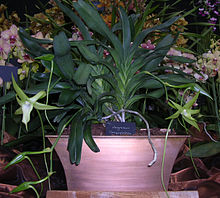Angraecum sesquipedale
| Angraecum sesquipedale | |
|---|---|
 |
|
| Angraecum sesquipedale | |
| Scientific classification | |
| Kingdom: | Plantae |
| (unranked): | Angiosperms |
| (unranked): | Monocots |
| Order: | Asparagales |
| Family: | Orchidaceae |
| Subfamily: | Epidendroideae |
| Tribe: | Vandaeae |
| Subtribe: | Angraecinae |
| Alliance: | Angraecum |
| Genus: | Angraecum |
| Species: | A. sesquipedale |
| Binomial name | |
|
Angraecum sesquipedale Thouars |
|
| Varieties | |
|
|
| Synonyms | |
| External identifiers for Angraecum sesquipedale | |
|---|---|
| NCBI | 78697 |
| Also found in: | |
Angraecum sesquipedale /ˌsɛskwᵻpᵻˈdeɪliː/, also known as Darwin's orchid, Christmas orchid, Star of Bethlehem orchid, and King of the Angraecums, is an epiphytic orchid in the genus Angraecum endemic to Madagascar. The orchid was first discovered by the French botanist Louis-Marie Aubert du Petit-Thouars in 1798, but was not described until 1822. It is noteworthy for its long spur and its association with the naturalist Charles Darwin, who surmised that the flower was pollinated by a then undiscovered moth with a proboscis whose length was unprecedented at the time. His prediction had gone unverified until 21 years after his death, when the moth was discovered and his conjecture vindicated. The story of its postulated pollinator has come to be seen as one of the celebrated predictions of the theory of evolution.
Angraecum sesquipedale is a monocot with monopodial growth and can grow to a height of 1 m (3.3 ft). Its growth habit is rather similar to species in the genus Aerides. The leaves are dark green with a bit of a grayish tone and leathery with a bilobed tip. They are usually around 20–40 centimeters (7.9–15.7 in) long and 6–8 cm (2.4–3.1 in) wide. The roots are dark gray, thick, and emerge from the orchid's stem. There tend to be few roots and they attach to the bark of the trees quite strongly. Each of the succulent roots can extend along the trunk of the tree for several meters.
...
Wikipedia
